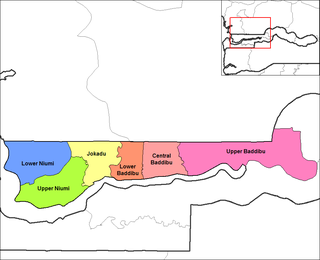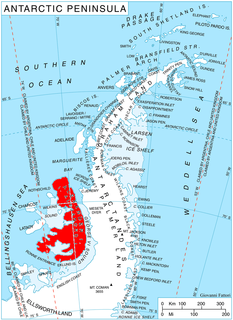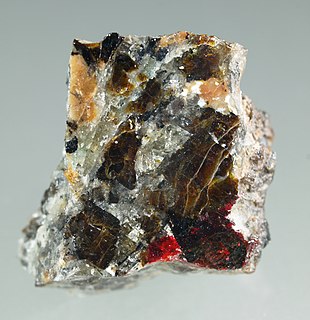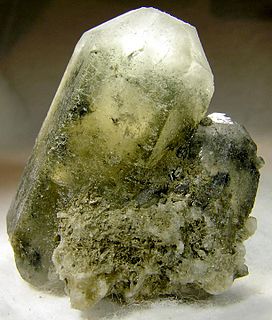This article needs additional citations for verification .(August 2022) |
Hopeton is a settlement in Jamaica. [1]
This article needs additional citations for verification .(August 2022) |
Hopeton is a settlement in Jamaica. [1]

The Arctic Archipelago, also known as the Canadian Arctic Archipelago, is an archipelago lying to the north of the Canadian continental mainland, excluding Greenland.

Anhydrite, or anhydrous calcium sulfate, is a mineral with the chemical formula CaSO4. It is in the orthorhombic crystal system, with three directions of perfect cleavage parallel to the three planes of symmetry. It is not isomorphous with the orthorhombic barium (baryte) and strontium (celestine) sulfates, as might be expected from the chemical formulas. Distinctly developed crystals are somewhat rare, the mineral usually presenting the form of cleavage masses. The Mohs hardness is 3.5, and the specific gravity is 2.9. The color is white, sometimes greyish, bluish, or purple. On the best developed of the three cleavages, the lustre is pearly; on other surfaces it is glassy. When exposed to water, anhydrite readily transforms to the more commonly occurring gypsum, (CaSO4·2H2O) by the absorption of water. This transformation is reversible, with gypsum or calcium sulfate hemihydrate forming anhydrite by heating to around 200 °C (400 °F) under normal atmospheric conditions. Anhydrite is commonly associated with calcite, halite, and sulfides such as galena, chalcopyrite, molybdenite, and pyrite in vein deposits.

Albite is a plagioclase feldspar mineral. It is the sodium endmember of the plagioclase solid solution series. It represents a plagioclase with less than 10% anorthite content. The pure albite endmember has the formula NaAlSi
3O
8. It is a tectosilicate. Its color is usually pure white, hence its name from Latin, albus. It is a common constituent in felsic rocks.

Tusionite is a rare colorless to transparent to translucent yellow brown trigonal borate mineral with chemical formula: MnSn(BO3)2. The mineral is composed of 18.86% manganese, 40.76% tin, 7.42% boron, and 32.96% oxygen. It is a late stage hydrothermal mineral and occurs rarely in granite pegmatites in miarolitic cavities.

Lower Baddibu is one of the six districts of the North Bank Division of the Gambia. In the 2013 census, it had a population of 18,030.

Pupiales is a town and municipality in the Nariño Department, Colombia.

Hopeton is an unincorporated community in Accomack County, Virginia.
The third Mohawk (YT‑17), later renamed YT-17 and YTL-17, was a tug that served in the United States Navy from 1898 to 1946.
The Findlay Group is a group of islands in the Arctic Archipelago in Qikiqtaaluk Region, Nunavut. This Arctic Ocean group consists of Lougheed Island, Stupart Island, Edmund Walker Island, Grosvenor Island and Patterson Island.
Empire Conyngham was a 1,408 GRT cargo ship that was built as Marie in 1899 by Neptun AG, Rostock, Germany for German owners. A sale in 1923 saw her renamed Norburg. She was sold to Latvia in 1925 and renamed Gauja, serving until 1941 when she was captured by the Kriegsmarine in the Baltic Sea. In 1945, she was seized by the Allies, passed to the Ministry of War Transport (MoWT) and was renamed Empire Conyngham. In 1946, she was scuttled with a cargo of obsolete bombs.

Mount Pinafore is a prominent peak rising to about 1,100 m lying between Bartok Glacier and Sullivan Glacier situated in the northern portion of Alexander Island, Antarctica. It is located 6.27 km southeast of Lyubimets Nunatak, 9.26 km south-southeast of Kozhuh Peak, and surmounts Bartók Glacier to the northwest. The mountain is named by the United Kingdom Antarctic Place-Names Committee in 1977, in association with nearby Gilbert Glacier and Sullivan Glacier after the 1878 operetta H.M.S. Pinafore.
Ichnusaite (pronounced iknusa-ait) is a very rarely found mineral. Ichnusaite is a natural compound of thorium and molybdenum with the formula Th(MoO4)2·3H2O. It was discovered in Su Seinargiu, Sarroch, Cagliari, Sardegna, Italy in 2013.The name is from the old Greek name of Sardinia, Ιχνουσσα, Ichnusa.
This locality is also a place of discovery of the second natural thorium molybdate - nuragheite.

Gurimite is a rare mineral with formula Ba3(VO4)2. It is a simple barium vanadate, one of the most simple barium minerals known. It is named after its type locality - Gurim anticline in Israel. It has formed in the rocks of the Hatrurim Formation. Gurimite's stoichiometry is similar to that of copper vanadates mcbirneyite and pseudolyonsite. An example of other barium vanadate mineral is tokyoite.
Faizievite is a very rare mineral with the formula K2Na(Ca6Na)Ti4Li6Si24O66F2. This triclinic mineral is chemically related to baratovite and katayamalite. Faizievite is a single-locality mineral, coming from the moraine of the Darai-Pioz glacier, Tien Shan Mountains, Tajikistan. Alkaline rocks of this site are famous for containing numerous rare minerals, often enriched in boron, caesium, lithium, titanium, rare earth elements, barium, and others.
Meisserite is a very rare uranium mineral with the formula Na5(UO2)(SO4)3(SO3OH)(H2O). It is interesting in being a natural uranyl salt with hydrosulfate (hydroxysulfate) anion, a feature shared with belakovskiite. Other chemically related minerals include fermiite, oppenheimerite, natrozippeite and plášilite. Most of these uranyl sulfate minerals was originally found in the Blue Lizard mine, San Juan County, Utah, USA.The mineral is named after Swiss mineralogist Nicolas Meisser.
Manganoblödite is a rare manganese mineral with the formula Na2Mn(SO4)2·4H2O. Somewhat chemically similar mineral is D'Ansite-(Mn). Manganoblödite was found in the Blue Lizard mine, San Juan County, Utah, US, which is known for several relatively new secondary uranium minerals In the mine, manganoblödite occurs intimately intergrown with manganese-, cobalt- and nickel-enriched blödite and a yet another new mineral - cobaltoblödite. Manganoblödite, as suggested by its name is a manganese-analogue of blödite. It is also analogous to changoite, cobaltoblödite and nickelblödite - all three are members of the blödite group.
The sulfate chlorides are double salts containing both sulfate (SO42–) and chloride (Cl–) anions. They are distinct from the chlorosulfates, which have a chlorine atom attached to the sulfur as the ClSO3− anion.

The sulfate carbonates are a compound carbonates, or mixed anion compounds that contain sulfate and carbonate ions. Sulfate carbonate minerals are in the 7.DG and 5.BF Nickel-Strunz groupings.
The sulfate nitrates are a family of double salts that contain both sulfate and nitrate ions (NO3−, SO42−). They are in the class of mixed anion compounds. A few rare minerals are in this class. Two sulfate nitrates are in the class of anthropogenic compounds, accidentally made as a result of human activities in fertilizers that are a mix of ammonium nitrate and ammonium sulfate, and also in the atmosphere as polluting ammonia, nitrogen dioxide, and sulfur dioxide react with the oxygen and water there to form solid particles. The nitro group (NO3−) can act as a ligand, and complexes containing it can form salts with sulfate.

The Auchlochan Collieries were several collieries in Auchlochan and Coalburn, South Lanarkshire, Scotland. Production started in 1894 and ended in 1968 when it closed. They were served at Auchlochan Platform railway station, part of the Coalburn Branch of the Caledonian Railway. Eight people were killed at the collieries.
Coordinates: 18°23′38″N77°52′01″W / 18.394°N 77.867°W